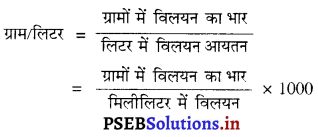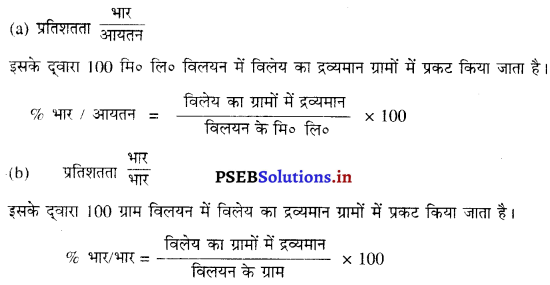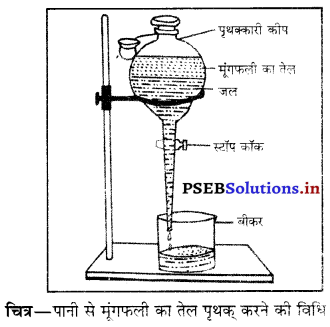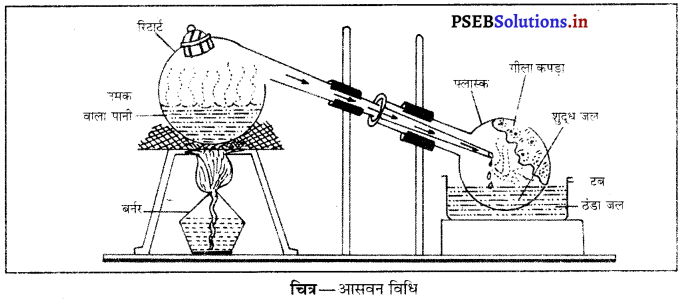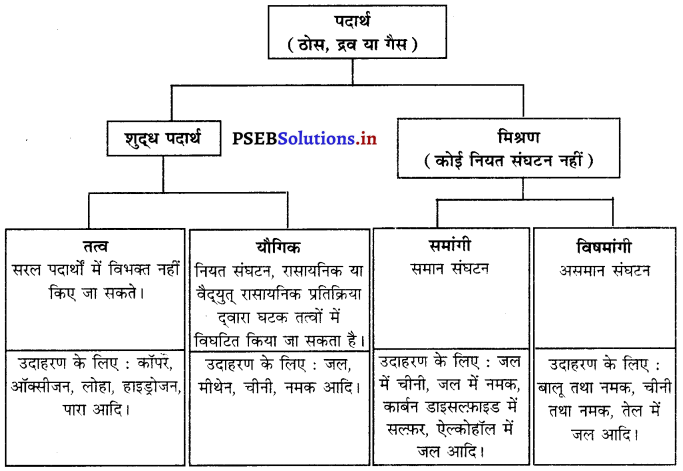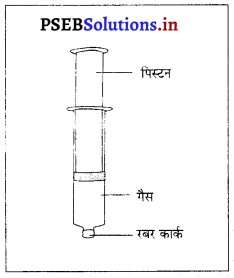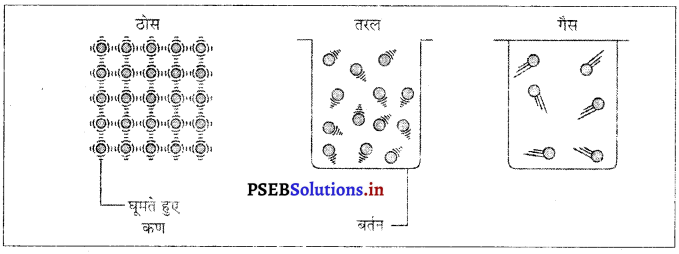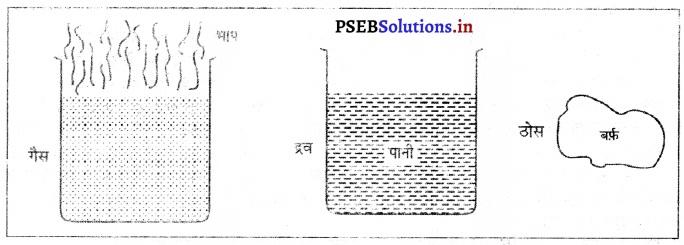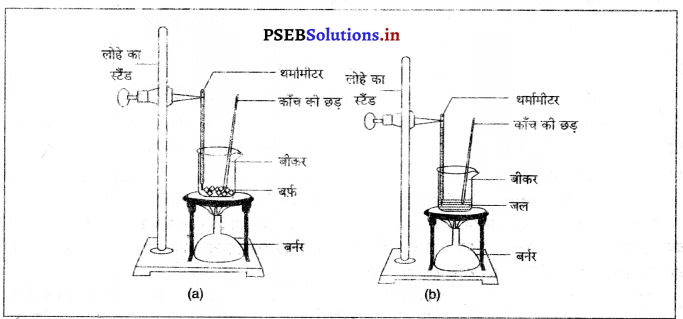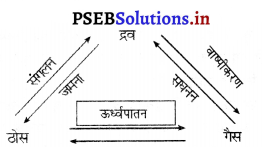Punjab State Board PSEB 9th Class Science Important Questions Chapter 7 जीवों में विविधता Important Questions and Answers.
PSEB 9th Class Science Important Questions Chapter 7 जीवों में विविधता
दीर्घ उत्तरात्मक प्रश्न (Long Answer Type Questions)
प्रश्न 1.
पादप जगत् को कितने उप-जगतों में विभाजित किया गया है ? उप-जगत् क्रिप्टोगैमी का सचित्र वर्णन करो।
उत्तर-
पादप जगत् (Division Planate) को दो उप-जगतों (i) क्रिप्टोगैमी (Cryptogamme) तथा फैनेरोगैमी (Phanerogamme) में विभाजित किया गया है।
उप-जगत् क्रिप्टोगैमी – इसके निम्नलिखित लक्षण हैं-
- इनमें जड, तने और पत्ते विकसित नहीं होते।
- इसमें जनन अंग छिपे हुए होते हैं। इसलिए दिखाई नहीं देते।
- इनमें पुष्प भ्रूण अवस्था तथा बीज नहीं होते।
इन्हें फिर तीन डिवीज़नों में विभाजित किया गया है।
- डिवीजन थैलोफाइटा (Division Thallophyta)
- डिवीजन ब्रायोफाइटा (Division Bryophyta)
- डिवीजन टैरीडोफाइटा (Division Pteridophyta) ।
डिवीज़न थैलोफाइटा – इसके निम्नलिखित लक्षण हैं-
- इन पौधों का शरीर जड़, तना तथा पत्ती में विभाजित नहीं होता।
- इन पौधों के शरीर को सुकाय (Thallus) कहते हैं।
- जनन अंग सरल और साधारण होते हैं।
- इन पौधों के युग्मक में भ्रूण नहीं बनता। शैवाल, कवक तथा लाइकन इस डिवीज़न के अंतर्गत आते हैं।

शैवाल के लक्षण-
- यह सामान्य जल में पाए जाते हैं।
- इन पौधों में क्लोरोफिल होता है और ये अपना भोजन स्वयं बनाते हैं।
- इनका सूकाय एक कोशिकीय तथा बहुकोशिकीय और तंतुमय होता है।
- इनकी कोशिका भित्ति सेल्यूलोज और पैकटिक पदार्थों की बनी हुई होती है।
- ये अन्य पौधों की छालों पर, नम भूमि तथा दीवारों पर पाए जाते हैं।
- इनमें भोजन पदार्थ मांड के रूप में संचित होता है। स्पाइरोगाइरा, यूलोथ्रिक्स, क्लेडोफोरा, अल्वा आदि मुख्य शैवाल हैं।
कवकों के लक्षण-
- इनमें पर्ण हरित (Chlorophyll) नहीं पाया जाता इसलिए ये अपना भोजन स्वयं नहीं बना सकते।
- ये परजीवी तथा मृतोपजीवी या विषमपोषी होते हैं।
- ये धागों जैसी रचनाओं जिन्हें कवक तंतु कहते हैं, के बने होते हैं, जो एक कोशिकीय या बह कोशिकीय होते हैं।
- कवक तंतु से निर्मित सूकाय को माइसीलियस कहते हैं।
- इनकी कोशिका भित्ति काइटन या कवक सेल्यूलोज या दोनों की बनी होती है।
- इनमें संचित भज्य पदार्थ तेल, वोल्यूटिन या ग्लाइकोजन के रूप में होता है। यीस्ट, राइजोपस, पेनिसिलियम, म्यूकर आदि मुख्य कवक हैं।
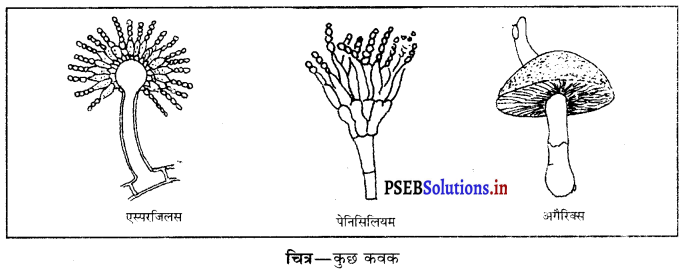
लाइकेन (Lichens) के लक्षण-
ये शैवाल तथा कवक के परस्पर सहयोग से बने सहजीवी पौधे हैं। ये पौधों जैसे प्रतीत होते हैं। शैवाल अवयव नीले हरे शैवाल अथवा हरे शैवाल होते हैं। शैवाल कवक को भोजन प्रदान करते हैं। कवक अवयव, शैवाल को खनिज, जल और सुरक्षा प्रदान करते हैं। ऐसा जीवन जिसमें दोनों सहयोगियों को एक-दूसरे से लाभ प्राप्त हो, को सहजीवन लाइकेन फोलिओज़ फ्रक्टिकोज लाइकेन (Symbiosis) कहते हैं। ये वृक्षों की छालों, नंगी चट्टानों, दीवारों तथा घरों की छत्तों आदि पर उगते हैं।
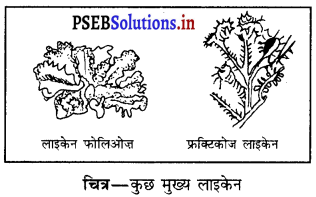
पार्मेलिया, ग्रेफिस, गाइरोफाइरा तथा असनिया मुख्य लाइकेन हैं।
डिवीज़न ब्रायोफाइटा के लक्षण-इसके मुख्य लक्षण निम्नलिखित हैं-
- इन पौधों का शरीर, जड़, तना तथा पत्तों जैसी रचनाओं में बंटा होता है।
- ये नमी वाले तथा छायादार स्थानों पर उगते हैं।
- इनमें संवहन ऊतक नहीं होते।
- इनमें युग्मकोद्मिद स्वतंत्र होता है तथा यह मुख्य पौधा होता है।
- ये युग्मकोद्मिद (Gametophyte) तथा बीजाणु उदभिद् (Sporophyte) पीढ़ी प्रदर्शित करते हैं।
इस खंड को निम्नलिखित दो वर्गों में बांटा गया है-
वर्ग 1. हिपेटिसी (Hepaticae) – इनका सुकाय चपटा और डारसीवेंट्रफ होता है। यह हरा सूकाय है। उदाहरणरिक्सीया (Riccia), मारकेंशिया।
वर्ग 2. मसाई (Musci) – मसाई समूह में नम और छायादार जगहों पर उगते हैं, पौधे का शरीर तने तथा पत्ती जैसी रचनाओं में बंटा होता है और यह वनस्पति धरती पर मेराइनोइस (Rhizoids) द्वारा लगाई जाती है।
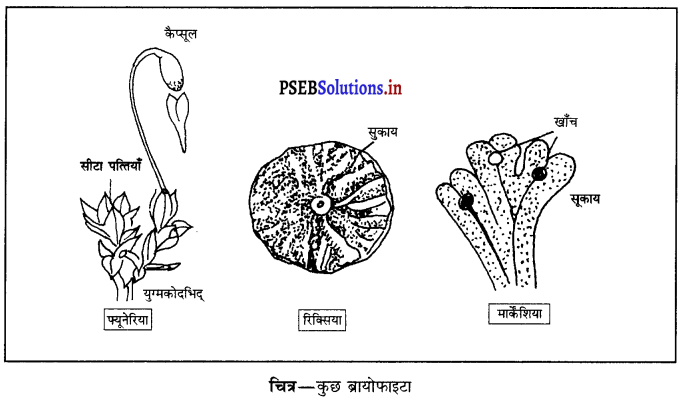
डिवीज़न टैरीडोफाइटा के लक्षण – इसके मुख्य लक्षण निम्नलिखित हैं-
- इनका शरीर जड़, तना तथा पत्तियों में विभाजित होता है।
- इसमें जनन अंग बहुकोशिकीय होते हैं।
- इनमें स्पोरेंजियम पत्ती की निचली सतह पर विकसित होते हैं।
- इनमें निषेचित अंडे से भ्रूण बनता है।
- पौधे पीढ़ी एकांतरण दर्शाते हैं।
उदाहरण टैरिस, सिलैजिनैला फर्न।
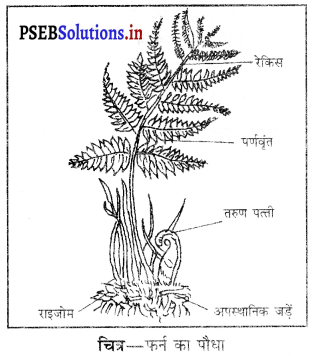
![]()
प्रश्न 2.
उप-जगत् फैनेरोगैमी के लक्षण बताओ। इसके विभिन्न उपखंडों का चित्र बनाकर वर्णन करो।
उत्तर-
फैनेरोगैमी के लक्षण- इसके मुख्य लक्षण निम्नलिखित हैं-
- इनका शरीर जड़, तना तथा पत्तियों में विभाजित होता है।
- इनमें संवहन ऊतक जाइलम तथा फ्लोएम बंडलों के रूप में उपस्थित होते हैं।
- इनमें बहुकोशिकीय जनन अंग होते हैं।
- इन पौधों में निषेचित अंडे से भ्रूण का निर्माण होता है।
- इन्हें बीजों वाले पौधे कहते हैं।
इन बीजों वाले पौधों को निम्नलिखित दो उप-खंडों में विभाजित किया गया है-
(i) जिम्नोस्पर्म अथवा नग्न बीजी (Gymnosperms)
(ii) एंजिओस्पर्म (Angiosperms)
(i) जिम्नोस्पर्म अथवा नग्न बीजी पौधों के लक्षण-
- इन पौधों के फूलों को कोन (cone) कहते हैं। फूलों में दल तथा बाह्य दल नहीं होते।
- इनके बीज नग्न होते हैं।
- इनके जननांग शंकु के आकार के होते हैं।
- इनमें बीजांड गुरु बीजाणुपर्ण (megasporophyll) की सतह पर लगे हुए होते हैं।
पाइनस, चील, देवदार आदि इसके मुख्य उदाहरण हैं। - निषेचन के बाद एक या एक से अधिक भ्रूण उत्पन्न होते हैं।

(ii) ऐंजियोस्पर्म पौधों के लक्षण-
- इन पौधों के तने शाकीय अथवा काष्ठीय होते हैं।
- इनमें शाक, झाड़ी तथा वृक्ष आते हैं।
- इनके फूलों में दल तथा बाह्य दल पाए जाते हैं।
- इनके बीज फलों से ढके रहते हैं। इसे निम्नलिखित दो भागों में विभाजित किया जाता है-
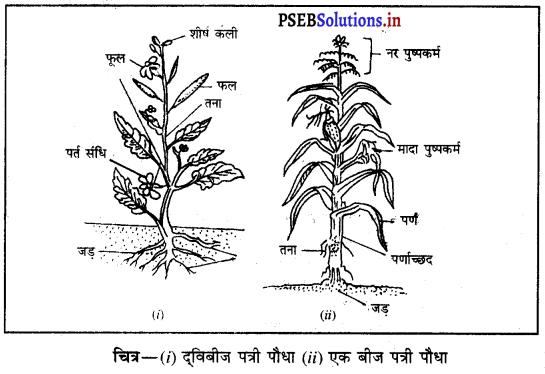
(i) द्विबीज पत्री (Dicotyledonous) – इनमें दो बीज-पत्र होते हैं।
उदाहरण – मटर तथा चना।
(ii) एक बीज पत्री (Monocotyledonous) – इनमें एक बीज-पत्र होता है।
उदाहरण – गेहूँ, मक्का तथा चावल आदि।
प्रश्न 3.
जंतु (प्राणी) जगत् के मुख्य फाइलमों के नाम लिखो। इनमें से प्रत्येक की एक या दो मुख्य विशेषताएं तथा उदाहरण दीजिए।
उत्तर-
जंतुओं (प्राणियों ) के कुछ प्रमुख फाइलम तथा उनके लक्षण और उदाहरण-
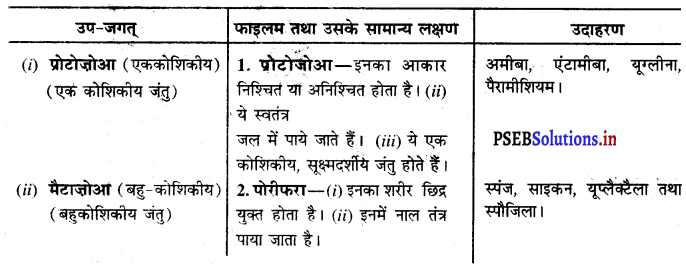
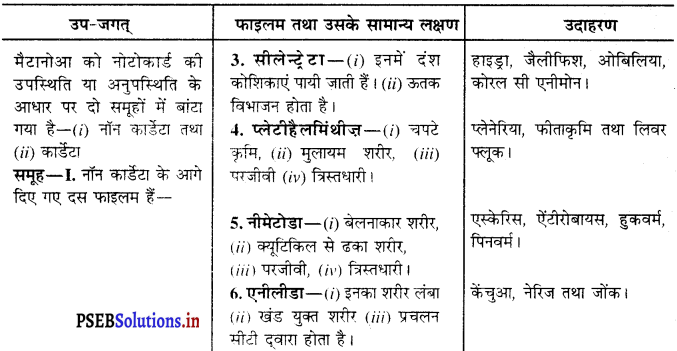
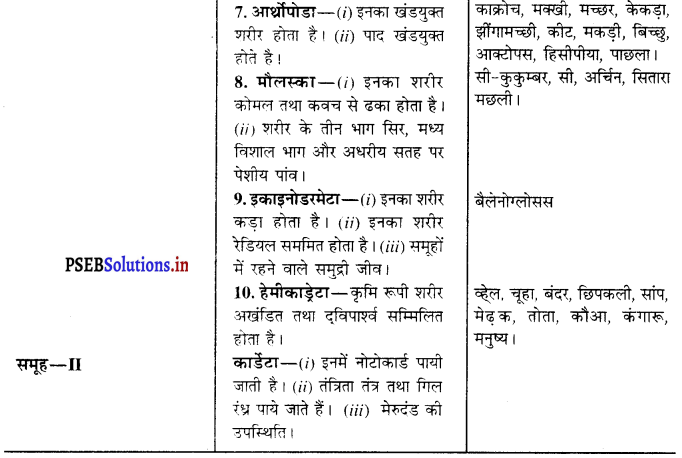
![]()
प्रश्न 4.
जंतु (प्राणी) जगत् के फाइलम प्रोटोजोआ तथा पोरीफैरा के लक्षणों का उदाहरण सहित वर्णन करो।
उत्तर-
फाइलम प्रोटोजोआ के लक्षण-
- ये अति आदिम तथा एक कोशिकीय जीव हैं।
- कुछ प्रोटोजोआ मृदु जल तथा समुद्रीय जल में पाए जाते हैं। इनमें कुछ स्वतंत्र जीवी तथा परजीवी भी होते हैं।
- इनमें प्रचलन कूट पाद, फ्लैजला अथवा सिलिया द्वारा होता है।
- इनमें पोषण जंतुसम (holozoic), पादपसम (Holophytic) तथा विषमपोषी होता है।
- इनमें श्वसन शरीर की सामान्य सतह द्वारा होता है।
- इनमें जनन खंडन अथवा बहुखंडन विधि अथवा सिस्ट उत्पत्ति द्वारा होता है।
अमीबा, यूग्लीना, पैरामीशियम, प्लाजमोडियम तथा ट्रिपनोसोमा इसके मुख्य उदाहरण हैं।
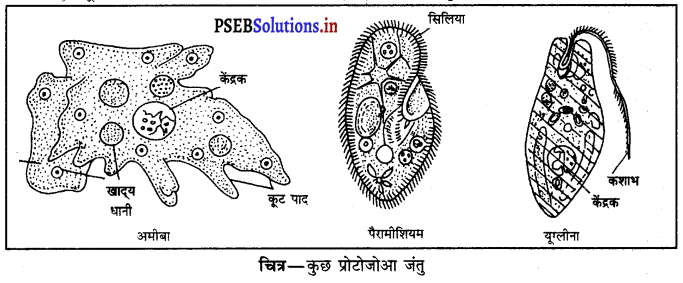
फाइलम पोरीफेरा के लक्षण-
- ये बहु-कोशिकीय होते हैं।
- ये प्रायः समुद्री जल में पाए जाते हैं।
- इनकी देहभित्ति दो स्तरों की बनी हुई होती है।
- इनमें तंत्रिका तंत्र तथा कंकाल तंत्र विकसित नहीं होती है।
- इनमें नाल तंत्र (Canal System) उपस्थित होती है।
- इनमें शरीर में छोटे-छोटे छिद्र और एक बड़ा छिद्र (Osculum) पाया जाता है।
- इनकी देह भित्ति की आंतरिक परत पर कालर कोशिकाएं पायी जाती हैं।
स्पंज, साइकॉन युप्लेक्टेला तथा स्पंजिला इसके मुख्य उदाहरण हैं।
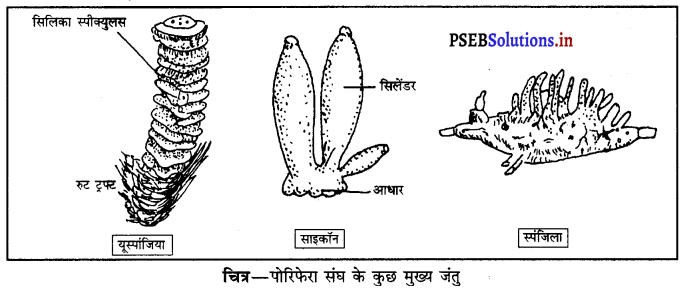
प्रश्न 5.
फाइलम सीलेन्ट्रेटा तथा प्लैटीहैलमिन्थीज के सामान्य लक्षण बताओ।
उत्तर-
फाइलम सीलेंट्रेटा के लक्षण-
- ये समुद्रों और ताज़े पानी में पाए जाते हैं। हाइड्रा (Hydra) ताजे पानी का जीव है।
- ये एकल अथवा कोलोनियल होते हैं।
- इनके कोलोनियल जीवों में पीढ़ी रूपांतरण होता है।
- इसके कुछ जंतुओं में लाइम का बाह्य कंकाल होता है। (कोरल)
- इनमें जनन अलैंगिक कलिका उत्पादन द्वारा तथा लैंगिक जनन मैडूयसा द्वारा होता है।
- इनमें स्टिंगिंग कोशिकाएं होती हैं जिन्हें निडोब्लास्ट कहते हैं।
- इन जंतुओं की रेडियल समिती होती है।
- इनमें दंश कोशिकाएं टैटेकलस पर पाई जाती हैं।
हाइड्रा, ओबिलिया, सी-एनीमोन तथा मूंगा इसके मुख्य उदाहरण हैं।
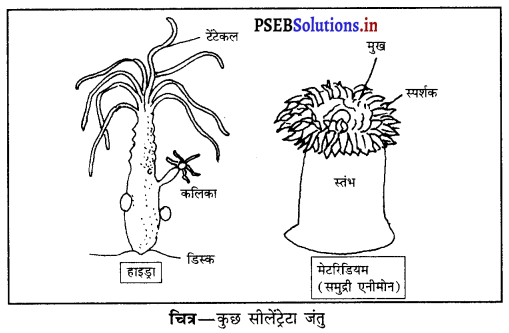
फाइलम प्लैटीहैलमिंथीज के लक्षण-
- ये प्रायः चपटे कृमि होते हैं।
- ये अधिकतर परजीवी होते हैं।
- इनका शरीर तीन स्तरों (layers) का बना हुआ होता है अर्थात् यह जंतु त्रिप्लोब्लास्टिक है।
- इनका शरीर पृष्ठ, अधर चपटा (dorsoventrally flattened) होता है।
- यह तरल आहार, पारगम्य विधि (Osmosis) द्वारा अवशोषित है।
- इनका शरीर द्विपार्श्व सममित होता है।
- ये प्रायः द्विलैंगिक होते हैं तथा इनका जनन तंत्र जटिल होता है।
- इन जंतुओं में शरीर गुहा नहीं होती।
फीता कृमि, प्लेनेरिया तथा लिवर फल्यूक इसके मुख्य उदाहरण हैं।
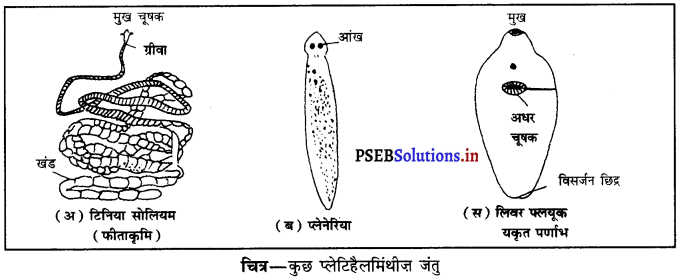
प्रश्न 6.
फाइलम अर्थोपोडा तथा एकाइनोडर्मेटा के मुख्य लक्षण बताओ।
उत्तर-

फाइलम अर्थोपोडा के लक्षण-
- इनका शरीर खंड युक्त होता है।
- इनके खंड पर प्रायः एक जोड़ी संधि युक्त टांगें होती हैं।
- इनका शरीर बाहर की ओर जुड़ा हुआ तथा द्विपार्श्व सममित होता है।
- इनमें शरीर गुहा (Haemocoel) होती है।
- इसके मुंह के भागों पर पार्श्व जबड़े होते हैं जो फाड़ने, काटने तथा चबाने तथा चूसने के लिए रूपांतरित होते हैं।
- इनके शरीर का काइटिन का बना कठोर निर्जीव तथा बाह्य कंकाल होता है।
- इनका परिवहन तंत्र खुले प्रकार का होता है।
कॉकरोच, प्राण (पेलिमोन), केंकड़ा, बिच्छू, मक्खी, मधुमक्खी, मच्छर, सैंटीपीड, मिलिपीड आदि इस फाइलम के मुख्य उदाहरण हैं।
फाइलम एकाइनोडर्मेटा के लक्षण-
- इस फाइलम के जंतुओं की त्वचा कांटेदार (spinous) होती है।
- इनके शरीर के खंड (segments) नहीं होते।
- इनकी त्वचा शरीर के बाहर की ओर कांटेदार चूने की (CaCO3) कवच बनाती है।
- इस फाइलम के लगभग सभी जंतु समुद्रों में पाए जाते हैं।
- इनमें सीलोम तथा जल संवहन तंत्र (water vascular system) पाया जाता है।
- इनका प्रचलन खोखली माल पाद की सहायता से होता है। (7) इनमें लिंग अलग-अलग भी होते हैं और कुछ द्विलिंगी भी होते हैं।
- इनमें पुनरुद्भवन (Regeneration) की क्षमता होती है।
समुद्री आर्चिन, सितारा मछली, एंटीडॉन तथा होलोथुरिया या सी-कुकम्वर इसके कुछ मुख्य उदाहरण हैं।
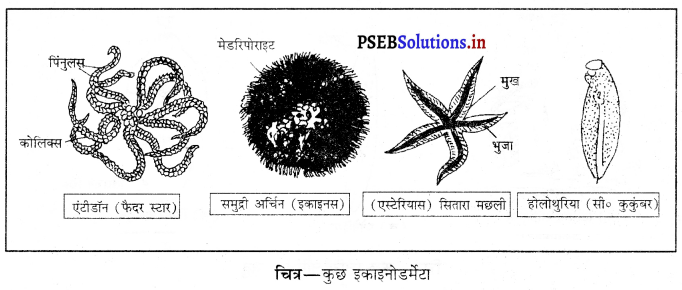
![]()
प्रश्न 7.
अधिवर्ग मत्स्य के लक्षण बताइए। इसे कितने वर्गों में बांटा गया है ? प्रत्येक का उदाहरण सहित वर्णन करो।
उत्तर-
अधिवर्ग मत्स्य (Superclass Pisces) – इसमें सभी मछलियां आती हैं। ये नदियों, तालाबों, पोखरों, नहरों व समुद्रों में पाई जाती हैं । इसके निम्नलिखित लक्षण हैं –
- इनका शरीर असमतापी तथा धारारेखित होता है।
- ये क्लोम (gills) द्वारा श्वसन करती हैं।
- इनका बाह्य कंकाल शल्कों का बना हुआ होता है।
- इनमें पार्श्व रेखा तंत्र उपस्थित होता है।
- इनमें बाह्य कान नहीं होते।
- इनके हृदय में एक आलिंद तथा एक निलय दो भाग होते हैं।
अधिवर्ग मत्स्य को निम्नलिखित तीन वर्गों में विभाजित किया गया है-
1. वर्ग प्लेकोडर्मी (Placodermi) – इस वर्ग की मछलियाँ अब लुप्त हो गई हैं । इनके के वल जीवाश्म ही पाए जाते हैं।
उदाहरण – क्लाइमेटियस।
2. वर्ग कांडिकथीज (Chondrichthyes) के लक्षण-
- इस वर्ग की मछलियाँ प्रायः समुद्रों में पाई जाती हैं।
- इनका अंत: कंकाल उपास्थि का बना होता है ।
- इनका बाह्य कंकाल शल्कों का बना होता है।
- इनके दांत एक ही आकार के होते हैं।
- इनमें श्वसन गलफड़ों द्वारा होता है तथा गिल्ज की संख्या 5-7 तक होती है।
- कुत्ता मछली, विद्युत् मीन, टोरपीडो आदि इसके मुख्य उदाहरण हैं।
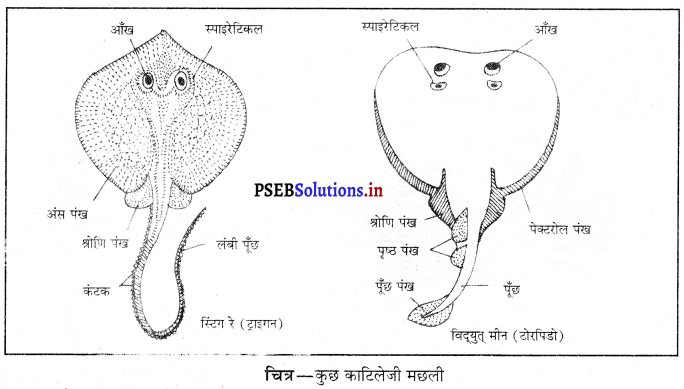
3. वर्ग आस्टिक्थीज़ (Osteichthyes) के लक्षण-
- इनका अंतः कंकाल अस्थि का बना हुआ होता है।
- यह समुद्रों, नहरों, नदियों, तालाबों आदि में पाई जाती हैं।
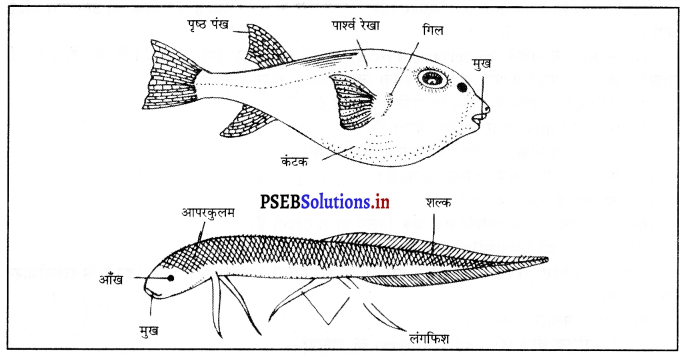
- इनका मुख अग्र होता है तथा जबड़े पूरी तरह विकसित होते हैं।
- इनके गिल्स आपरकुलम की सहायता से ढके हुए होते हैं।
- इस वर्ग की कुछ मछलियों में वाताशय (Air bladder) भी पाए जाते हैं।
- इस वर्ग की मछलियाँ एक-लिंगी होती हैं।
एनाबास, रोहू, उड़ने वाली मछली, दरियाई घोड़ा तथा लंगफिश इसके कुछ मुख्य उदाहरण हैं।
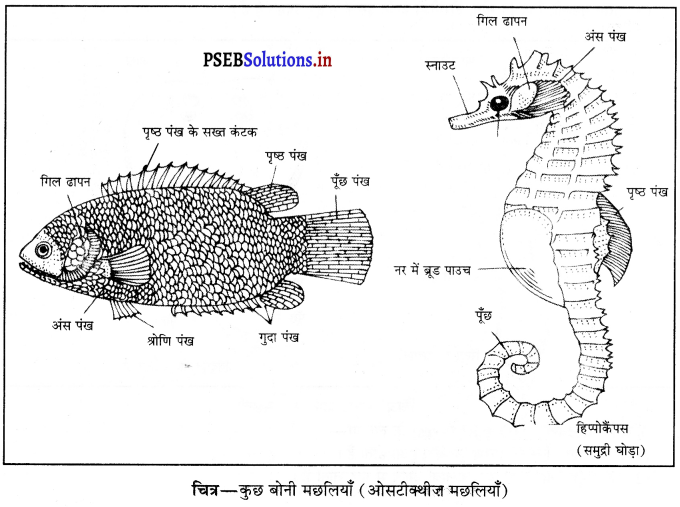
प्रश्न 8.
जलस्थलचर श्रेणी तथा सरीसृप श्रेणी के जीवों के लक्षण बताओ।
उत्तर-
जलस्थलचर श्रेणी के लक्षण-
- ये जंतु जल तथा थल दोनों स्थानों पर पाए जाते हैं।
- इनका शरीर असमतापी (Cold blooded) होता है।
- ये गिल्स, त्वचा तथा फेफड़ों द्वारा श्वसन करते हैं।
- इनमें अग्रम और पिछले पैर होते हैं।
- इनके पैरों की पांच उंगलियां होती हैं।
- इनके हृदय के तीन भाग होते हैं।
- ये एक लिंगी जंतु हैं।
- कई जंतुओं के शरीर पर दाने (warts) होते हैं।
मेंढक, टोड, हाइला तथा सेलेमेंडरा इस वर्ग के मुख्य उदाहरण हैं।
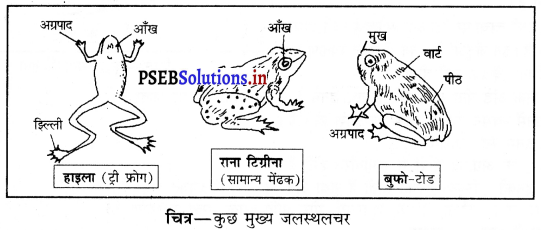
सरीसृप श्रेणी के मुख्य लक्षण-
- यह रींगने वाले जंतु हैं। इनकी त्वचा सूखी तथा ग्रंथि विहीन होती है।
- इनकी त्वचा पर शल्क होते हैं।
- इनका अंत: कंकाल उपचर्नीय शल्कों का बना होता है।
- इनमें दो जोड़ी पांच अंगुली पाद होते हैं।
- ये असमतापी जंतु हैं।
- इनका शरीर सिर, ग्रीवा, धड़ तथा पूंछ में विभाजित होता है।
- इनकी लंबाई और भार काफ़ी अधिक हो सकती है।
- ये प्रायः स्थलीय जंतु हैं तथा गर्म प्रदेशों में पाए जाते हैं।
- यह एक लिंगी जंतु है। इनमें निषेचन मादा के शरीर के अंदर होता है।
छिपकली, सांप, कछुआ तथा मगरमच्छ रेप्टीलिया या सरीसृप वर्ग के मुख्य उदाहरण हैं।
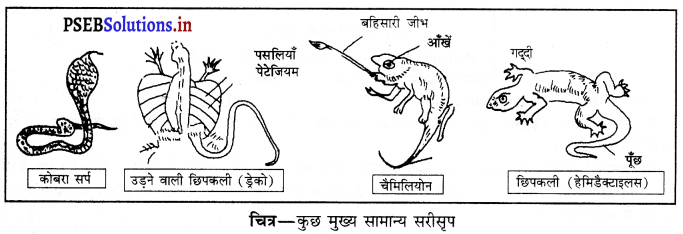
प्रश्न 9.
पक्षी श्रेणी तथा स्तनधारी श्रेणी के मुख्य लक्षण बताओ।
उत्तर-

पक्षी श्रेणी के लक्षण-
- ये समतापी (Warm blooded) जंतु हैं।
- इनका शरीर पखे की तरह होता है।
- इनमें चोंच उपस्थित होती है परंतु दांत नहीं होते।
- इनकी त्वचा पर तेल और सफेद रंग की ग्रंथियां पाई जाती हैं।
- इनके हृदय के चार कोश-दो आलिंद तथा दो निलय होते हैं।
- इन जंतुओं के कान होते हैं और शरीर पंखों से ढका होता है।
- इनकी त्वचा पर तेल और सफेद रंग की ग्रंथियां पाई जाती हैं। इन जंतुओं के रक्त में लाल रक्ताणु पाए जाते हैं जिनमें केंद्रक नहीं होता।
- इनके अंडे पीत युक्त होते हैं तथा इनमें भ्रूण झिल्लियां भी पाई जाती हैं।
- इनमें श्वसन तंत्र के साथ वायुकोश होते हैं।
- इनमें स्तन ग्रंथियाँ होती हैं।
- इनके अग्रपाद पंखों में रूपांतरित होते हैं।
- इनकी अस्थियां हल्की होती हैं तथा अंतः कंकाल छिद्रयुक्त होता है।
कबूतर, तोता, कौआ, गोरैया, शुतुरमुर्ग, मोर आदि इसके मुख्य उदाहरण हैं।
स्तनधारी श्रेणी के लक्षण-
- यह समतापी जंतु है।
- ये विभिन्न आकार के होते हैं तथा इनके शरीर पर बाल होते हैं।
- इनमें बाह्य कान उपस्थित होता है।
- पेट में पेट पर्दा (डायाफ्राम) होता है।
- इनकी त्वचा पर तेल तथा स्वेद ग्रंथियां पाई जाती हैं।
- इनके हृदय के चार कोश-दो आलिंद तथा दो निलय होते हैं।
- इनमें लाखों रक्त कणिकाएं होती हैं जो केंद्रक विहीन होती हैं।
- इनके दांत विषदंती (Heterodont) तथा गर्तदंती (Thecodont) होते हैं। ये जीवन में दो बार निकलते हैं।
- ये बच्चों की बहुत अधिक देखभाल करते हैं।
चूहा, बंदर, कंगारू, हाथी, चमगादड़, गिलहरी, शेर, मनुष्य आदि इसके कुछ मुख्य उदाहरण हैं।
![]()
लघु उत्तरात्मक प्रश्न (Short Answer Type Questions)
प्रश्न 1.
वर्गिकी (Taxonomy) तथा वर्गीकरण पद्धति (Systematics) क्या है ?
उत्तर-
वर्गिकी (Taxonomy) – जीव विज्ञान की वह शाखा जिसका संबंध सजीवों के वर्गीकरण से हो, वर्गिकी कहलाती है।
वर्गीकरण पद्धति (Systematics) – वर्गीकरण विज्ञान का वर्गीकरण पद्धति वर्गिकी से भिन्न है। यह सभी जीवों की विविधता है। वर्गीकरण पद्धति में सजीवों को उनके गुणों तथा परस्पर निर्भरता के आधार पर भिन्न-भिन्न समूहों में बांटा जाता है।
प्रश्न 2.
वर्गीकरण क्या है ?
इसके महत्त्व बताइए।
उत्तर-
वर्गीकरण (Classification) – जीवों को उनकी समानताओं तथा असमानताओं के आधार पर विभिन्न ग्रुपों में विभाजित करने की विधि को वर्गीकरण कहते हैं।
वर्गीकरण का महत्त्व – वर्गीकरण निम्नलिखित कारणों से महत्त्वपूर्ण है-
- यह विभिन्न प्रकार के जीवों के अध्ययन को सरल बनाता है।
- यह सभी जीवों की एकदम स्पष्ट तस्वीर प्रदान करता है।
- यह जीवों के विभिन्न समूहों के बीच संबंध के बारे में बतलाता है।
- यह जीव विज्ञान की अन्य शाखाओं को आधार प्रदान करता है।
- भूगोल का अध्ययन पूर्णतया पौधों तथा जंतुओं के वर्गीकरण पर आधारित है।
- जीव विज्ञान की अन्य शाखाएं जैसे परिस्थितिकी, कोशिका विज्ञान, कायिकी आदि का विकास वर्गीकरण के कारण ही संभव हुआ है।
प्रश्न 3.
जीवों के स्थानीय नाम क्यों पर्याप्त नहीं हैं ? वैज्ञानिक नामों के क्या लाभ हैं ?
उत्तर-
जीवों को पहचानने के लिए स्थानीय नाम पर्याप्त नहीं हैं क्योंकि स्थानीय नाम भिन्न-भिन्न भाषाओं में भिन्न-भिन्न होते हैं। उदाहरण के लिए एक कुत्ते को हिंदी में कुत्ता, तमिल में ‘नाई’ तथा बंगला में ‘कुकुर’ कहते हैं। इसी प्रकार अन्य जीवों के लिए भी भिन्न-भिन्न भाषाओं में भिन्न-भिन्न नाम प्रयोग किए जाते हैं। इसलिए जीवों को संसार में सभी स्थानों पर जानने के लिए स्थानीय नाम पर्याप्त नहीं है।
सारे संसार में जंतुओं को जानने तथा पहचानने के लिए वैज्ञानिक नाम देना अति आवश्यक है। पौधों तथा जंतुओं को नाम देना नामकरण कहलाता है। जीवों को वैज्ञानिक नाम देने की पद्धति कोरोलस लिनियस ने दी। इसे द्विपद नाम पद्धति कहते हैं। इस पद्धति के अनुसार सारे संसार में किसी भी जीव का नाम एक ही रहेगा। इस प्रकार स्थानिक नामों द्वारा पैदा हुई समस्या समाप्त हो गई।
वैज्ञानिक नाम रखने के लाभ – वैज्ञानिक नाम रखने से समस्त विश्व में सजीवों की पहचान आसान हो गई है तथा हर प्रकार की कठिनाई समाप्त हो गई है।
प्रश्न 4.
वर्गीकरण की विभिन्न श्रेणियां बताइए।
उत्तर-
वर्गीकरण की विभिन्न श्रेणियां निम्नलिखित हैं-
| (1) जगत (Kingdom) | सर्वोच्च श्रेणी जिसमें सभी जंतु तथा पौधे शामिल हैं। |
| (2) फाइलम (Phylum) | यह वर्ग से उच्चतम होती है। वर्गों को मिलाकर फाइलम बनाते हैं। |
| (3) वर्ग (Class) | आर्डरस मिलकर वर्ग बनाते हैं। |
| (4) आर्डर (Order) | कुल मिलकर आर्डर बनाते हैं। |
| (5) कुल (Family) | इसमें प्रजातियां शामिल हैं। |
| (6) जीनस (Genus) | जातियां मिलकर जीनस अथवा प्रजाति बनाती हैं। |
| (7) जाति (Species) | यह जीवों की निम्नतम श्रेणी है। (एक समान गुणों और आपस में जनन करने वाले सजीव आते हैं।) |
प्रश्न 5.
बाघ तथा आम का श्रेणीबद्ध वर्गीकरण कीजिए।
उत्तर-
बाघ तथा आम का श्रेणीबद्ध वर्गीकरण-
| श्रेणी | बाघ (Tiger) | आम (Mango) |
| जगत (Kingdom) | एनिमेलिया | पादप (Plantae) |
| ह्यसंघ (Phylum) | कार्डेटा | ट्रेकियोफाइटा (Tracheophyta) |
| उपसंघ (Sub-Phylum) | वर्टिब्रेटा | ……………. |
| वर्ग (Class) | स्तनधारी | मौंगलिओपसिडा (Magnoliopsida) |
| गण (Order) | कार्निवोरा | सेपिंडेलस (Spindal) |
| वंश (Genus) | पेंथेरा | मैंगिफेरा (Mangifera) |
| जाति (Species) | टाइग्रिस | इंडिका (indica) |
![]()
प्रश्न 6.
द्विबीजपत्री तथा एकबीजपत्री पौधों में अंतर बताओ।
उत्तर-
दविबीजपत्री तथा एकबीजपत्री पौधों में अंतर-
| द्विबीजपत्री | एकबीजपत्री |
| (1) इनके बीज में दो बीजपत्र होते हैं। | (1) इनके बीज में केवल एक बीजपत्र होता है। |
| (2) इनकी पत्तियों में जालिकावत शिरा विन्यास होता है। | (2) इनकी पत्तियों में समानांतर शिरा विन्यास होता है। |
| (3) इनमें मूसला जड़ तंत्र पाया जाता है। | (3) इनमें रेशेदार जड़ तंत्र पाया जाता है। |
| (4) इनमें द्वितीयक वृद्धि होती है। | (4) इनमें द्वितीयक वृद्धि नहीं होती। |
| (5) इनमें पुष्प पंचतयी होते हैं। | (5) इनके पुष्प त्रिपयी होते हैं। |
प्रश्न 7.
शैवाल का आर्थिक महत्त्व बताओ।
उत्तर-
शैवाल का आर्थिक महत्त्व-
- यह मछली तथा अन्य जलीय जंतुओं हेतु भोजन प्रदान करती है।
- यह जल में ऑक्सीजन तथा कार्बन डाइऑक्साइड के समुचित संतुलन का प्रबंध करती है।
- यह जल को स्वच्छ रखती है।
- यह प्रोटीन का अच्छा स्रोत है।
- शैवाल की कुछ जातियों से आयोडीन प्राप्त होती है।
- रेड एल्गी से (जैसे जिलेडियम) अगर-अगर (Agar-Agar प्राप्त होता है।
- कुछ शैवालों से दवाइयाँ बनाई जाती हैं।
- कुछ शैवाल तेलीय पदार्थ स्रावित करते हैं।
प्रश्न 8.
फाइलम एनीलिडा के सामान्य लक्षण बताओ।
उत्तर-
फाइलम एनीलिडा के सामान्य लक्षण-
- ये जीव पानी, नमी युक्त स्थानों तथा समुद्र में पाए जाते हैं।
- ये लंबे शरीर वाले जंतु त्रिस्तरीय होते हैं।
- इनका शरीर द्विपार्श्व सममित होता है।
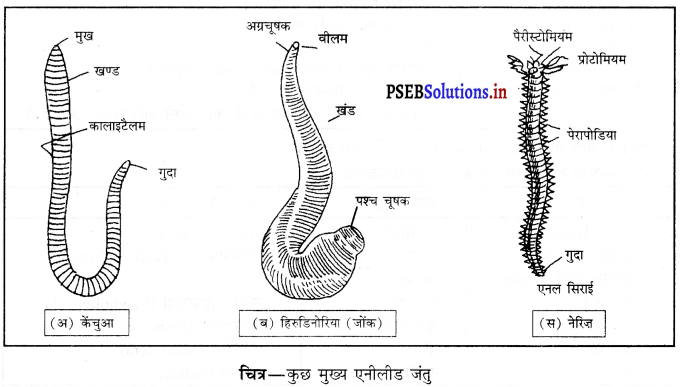
- इनमें नैफरिडिया द्वारा उत्सर्जन होता है।
- शरीर को गति सीट (Setae) अथवा पेरापोडिया (Parapodia) द्वारा मिलती है।
- इनमें एक लिंगी, दो लिंगी दोनों तरह के जीव पाये जाते हैं।
- इनके तंत्रिका तंत्र में एक अर्ग नर्व रिंग तथा एक अधर नर्वकार्ड पायी जाती है।
केंचुआ, नेरिज़ तथा जोंक इसके मुख्य उदाहरण हैं।
प्रश्न 9.
फाइलम मोलस्का के सामान्य लक्षण बताओ।
उत्तर-
फाइलम मोलस्का के लक्षण-
- यह जीव जलीय तथा स्थलीय दोनों प्रकार के होते हैं।
- इनका शरीर कोमल तथा अखंडित होता है।
- इनके शरीर में सिर, पाद तथा पिंडक तीन भाग होते हैं।
- इनमें लिंग प्रायः अलग-अलग होते हैं।
- यह गिल्स द्वारा श्वसन करता है जिन्हें टिनिया कहते हैं।
- यह पादों द्वारा प्रचलन करता है।
पाइला, यूनिओ, काइटन तथा ओक्टोपस इसके मुख्य उदाहरण हैं।
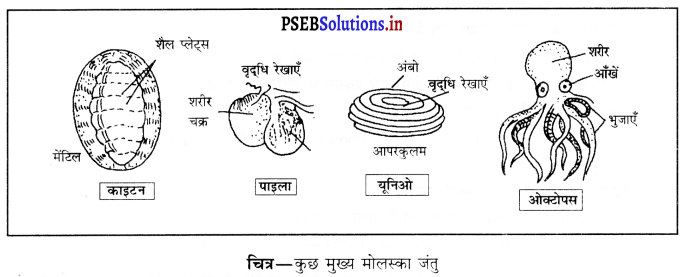
प्रश्न 10.
संघ नीमेटोडा के मुख्य लक्षण बताओ।
उत्तर-
संघ नीमेटोडा के लक्षण-
- इनमें प्रायः गोल कृमि आते हैं।
- इनका शरीर द्विपार्श्व सममित होता है।
- इनका शरीर तीन स्तरों का बना होता है तथा अखंडित है।
- इनमें श्वसन अंग तथा संवहन तंत्र अनुपस्थित होता है।
- शारीरिक गुहा शुद्ध नहीं होती।
- इनकी आहार नाल में पेशी स्तर नहीं होता परंतु यह पूर्ण होती है। गोल कृमि, ऑक्सीयूरिस, पिन वर्म इसके मुख्य उदाहरण हैं।
![]()
प्रश्न 11.
कॉर्डेटा की चार मुख्य विशेषताएं क्या हैं ?
उत्तर-
कॉर्डेटा की चार मुख्य विशेषताएं-कॉर्डेटा की मुख्य विशेषताएं निम्नलिखित हैं-
- नालाकार नर्वकार्ड – इनमें एक खोखली नालाकार नर्वकार्ड अथवा तंत्रिका रज्जु पाई जाती है।
- नोटोकार्ड की उपस्थिति – सभी कॉर्डेटा में जीवनभर या जीवन की किसी अवस्था में एक ठोस लचीली नोटोकार्ड पायी जाती है।
- ग्रसनी क्लोम दरारें (Pharyngeal gill slits) – सभी कॉर्डेटों में एक छिद्रित ग्रसनी पाई जाती है। यह लारवा अवस्था में अथवा सारे जीवन में रहती है।
- गुदा के पीछे पूंछ – सभी कॉडेंटों की गुदा के पीछे पूंछ पायी जाती है।
प्रश्न 12.
नॉन-कॉर्डेटा के मुख्य लक्षण बताओ।
उत्तर-
नॉन-कॉर्डटा के लक्षण-
- इसमें नोटोकार्ड नहीं होता।
- इनमें गिल्स उपस्थित होती हैं तथा श्वसन प्रायः बाह्य त्वचा से होता है।
- इसमें केंद्रीय तंत्रिका तंत्र ठोस होता है।
- ये जंतु प्रायः जल में पाए जाते हैं।
- इनमें रुधिर प्रायः रंगहीन होता है।
- इसमें वास्तुविक पूंछ नहीं होती तथा अस्थि कंकाल अनुपस्थित होता है।
प्रश्न 13.
संघ हेमीकाटा के मुख्य लक्षण बताओ।
उत्तर-
संघ हेमीकाटा के मुख्य लक्षण-
- इनका शरीर द्विपार्श्व सममिति होता है।
- यह जंतु प्रायः समुद्र में पाए जाते हैं।
- इनमें काटा और नॉन-कॉडेटा दोनों के लक्षण पाए जाते हैं।
- इनकी ग्रसनी के बाहर की ओर क्लोम दरारें श्वसन में सहायक होती हैं।
- यह कृमि एक लिंगी होते हैं।
- इनके शरीर के तीन भाग होते हैं। शुंड (Proboscis), कालर और धड़ (Trunk)।
- ये कृमि रूपी जंतु होते हैं।
उदाहरण – बैलेनोग्लोसस, सैफेलोडिस्कस।
प्रश्न 14.
जिम्नोस्पर्मस तथा टेरिडोफाइटा में अंतर बताओ।
उत्तर-
जिम्नोस्पर्मल तथा टेरिडोफाइटा पौधों में अंतर-
| जिम्नोस्पर्मस | टेरिडोफाइटा |
| (1) यह सम शीतोष्ण कटिबंध (temperate) जलवायु वाले भागों में पाये जाते हैं। | (1) यह छायादार तथा नम स्थानों में पाए जाते हैं। |
| (2) इनमें कैंबियम उपस्थित होता है। | (2) इनमें कैंबियम अनुपस्थित होता है। |
| (3) इनमें पोलेन ट्यूब बनती है। | (3) इनमें पोलेन ट्यूब नहीं बनती। |
| (4) इनमें ग्रीवा नाल कोशिकाएँ नहीं होतीं। | (4) इनमें ग्रीवा नाल कोशिकाएँ उपस्थित होती हैं। |
प्रश्न 15.
निम्नलिखित में अंतर लिखिए-
(क) नॉन कॉर्डेट्स और कॉर्डेट्स
(ख) अस्थिल भीन और उपस्थिमय मीन।
उत्तर-
(क) नॉन कॉर्डेट्स और कॉर्डेट्स में अंतर-
| नॉन कॉर्डेट्स | कॉडेट्स |
| (1) केंद्रीय तंत्रिका का तंत्र ठोस है। | (1) केंद्रीय तंत्रिका तंत्र खोखला और नलिकाकार होता है। |
| (2) केंद्रीय तंत्रिका तंत्र आहार नाल के नीचे अधर तल पर होता है। | (2) कंद्रीय तंत्रिका तंत्र आहार नाल के पीछे होता है। |
| (3) क्लोम विदर नहीं पाए जाते हैं। | (3) क्लोम विदर पाए जाते हैं। |
| (4) नोटोकॉर्ड नहीं पाई जाती। | (4) नोटोकॉर्ड पाई जाती है। |
| (5) आहार नाल के पिछले हिस्से में हृदय पाया जाता है। | (5) आहार नाल के नीचे हृदय विद्यमान होता है। |
(ख) अस्थिल मीन और उपस्थिमय मीन में अंतर
| अस्थिल मीन | उपस्थिमय मीन |
| (1) इनका कंकाल अस्थियों से निर्मित होता है। | (1) इनका कंकाल उपस्थियों से निर्मित होता है। |
| (2) इनमें वाताशय (Air Bladder) होता है। | (2) इनमें वाताशय (Air Bladder) नहीं होता। |
| (3) इन पर चकाभ और कंकताभ शलक होता है। | (3) इन पर फ्लैकॉयड शल्क होता है। |
![]()
प्रश्न 16.
निम्नलिखित में अंतर लिखिए-
(क) स्तनधारी और उभयचर
(ख) शैवाल और कवक।
उत्तर-
(क) स्तनधारी और उभयचर में अंतर-
| स्तनधारी | उभयचर |
| (1) ये प्राय: स्थल पर रहते हैं। | (1) यह जल और स्थल दोनों पर रहते हैं। |
| (2) ये समतायी होते हैं। | (2) ये असमतायी होते हैं। |
| (3) इन पर बाल पाए जाते हैं। | (3) इन पर बाल नहीं होते। |
| (4) इन की त्वचा शुष्क और मोटी होती है। | (4) इनकी त्वचा नम और कोमल होती है। |
| (5) इनके हृदय में चार कक्ष होते हैं। | (5) इनके हृदय में तीन कक्ष होते हैं। |
| (6) इनमें प्रायः बाह्य कान होते हैं। | (6) इन में बाह्य कान प्रायः नहीं होते। |
| (7) ये प्रायः शिशुओं को जन्म देते हैं। | (7) इन के बच्चों का जन्म अंडों से होता है। |
(ख) शैवाल और कवक में अंतर-
| शैवाल | कवक |
| (1) ये जलीय होते हैं। | (1) ये स्थलीय होते हैं। |
| (2) इनकी जनन इकाइयां जलीय प्रवाह के कारण चल होती हैं। | (2) इनकी जनन इकाइयां अचल होती हैं। |
| (3) इन की कोशिका भित्ति सेलुलोज़ से बनी होती है। | (3) इनकी कोशिका भित्ति सेलुलोस से बनी होती है। |
| (4) इनमें भोजन मंड के रूप में होता है। | (4) इनमें भोजन ग्लाइकोजन के रूप में होता है। |
| (5) ये स्वपोषी होते हैं। | (5) ये मृत जीवी या परजीवी होते हैं। |
प्रश्न 17.
द्विपद् नामपद्धति क्या है ? एक उदाहरण की सहायता से स्पष्ट करिए।
उत्तर-
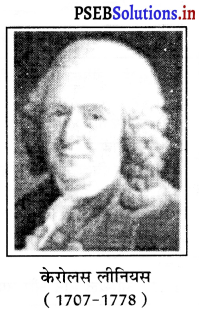
द्विपद् नामपद्धति – पौधों तथा जंतुओं के नामकरण की यह पद्धति केरोलस लिनियस ने विकसित की थी। इस पद्धति के अनुसार जीवों को वैज्ञानिक नाम दिए जाते हैं। प्रत्येक जंतु तथा पौधे को दो नाम दिए जाते हैं। एक जैनेरिक नाम तथा दूसरा स्पीशीज नाम। जैनेरिक वंश का नाम होता है। लिनियस को उसके इस कार्य के लिए वर्गीकरण विज्ञान का पिता कहा जाता है।
उदाहरणस्वरूप – आम का वैज्ञानिक नाम मैंगीफेरा इंडिका है। सरसों का वैज्ञानिक नाम ब्रासिका कंप्रेस्ट्रिस है। इसी प्रकार मनुष्य जाति का वैज्ञानिक नाम होमो सेपियंस है। इन सभी नामों में पहला जैनेरिक नाम तथा दूसरा स्पीशीज नाम है।
प्रश्न 18.
वर्गीकरण की द्वि-जगतीय प्रणाली की प्रमुख विशेषताएं क्या हैं ?
उत्तर-
द्वि-जगतीय प्रणाली – संसार के सभी जीवों-जंतुओं तथा पौधों को दो जगतों में विभाजित किया गया है-
(i) जगत् प्राणी (Animalae),
(ii) जगत् पादप (Plantae)
जगत् प्राणी के लक्षण-
- यह एक स्थान से दूसरे स्थान तक जा सकते हैं।
- ये अपना भोजन स्वयं नहीं बना सकते।
- इनकी कोशिका में कोशिका भित्ति नहीं होती।
- इनमें हरे रंग , क्लोरोफिल (पर्णहरित) नहीं होता।
जगत् पादप के लक्षा –
- ये एक स्थान पर स्थिर रहते हैं।
- यह अपने भोजन का स्वयं निर्माण करते हैं।
- इनकी कोशिका भित्ति सेल्यूलोज की बनी हुई होती है।
- इनमें हरे रंग का पदार्थ पर्णरहरित होता है।
प्रश्न 19.
जीवाणुओं और कवक को पौधों के साथ वर्गीकत क्यों किया गया है?
उत्तर-
जीवाणुओं तथा कवकों का रंग हरा नहीं होता। ये अपने भोजन दूसरे मृत अथवा जीवित जीवों से प्राप्त करते हैं। फिर भी इन्हें निम्नलिखित कारणों से पादपों के साथ रखा जाता है-
- जीवाणुओं तथा कवकों में पादपों के गुण होते हैं।
- इनकी कोशिका भित्ति सेल्यूलोज की बनी होती है।
- कवक अपना भोजन पौधों के समान घोल अवस्था में लेते हैं।
प्रश्न 20.
आइशलर द्वारा प्रस्तावित वनस्पति वर्गीकरण की रूपरेखा दीजिए।
उत्तर-
आइशलर द्वारा प्रस्तावित वनस्पति वर्गीकरण की रूपरेखा-

प्रश्न 21.
हेमीकॉर्डेटा, यूरोकॉर्डेटा तथा सीफेलोकॉर्डेटा के एक-एक उदाहरण दीजिए।
उत्तर-
- हेमीकॉर्डेटा-उदाहरण-बेलोनोग्लोसस ।
- यूरोकॉर्डेटा-उदाहरण-हर्डमानिया।
- सीफेलोकॉर्डेटा–उदाहरण-एंफी ओक्सस।
![]()
प्रश्न 22.
पीढ़ी एकांतरण क्या है ?
उत्तर-
पीढ़ी एकांतरण (Alternation of Generation) – किसी भी पौधे के जीवन काल में दो पीढ़ियों बीजाणु-उद्भिद (Sporophyte) तथा युग्मोकोदिभिद् (Gemetophyte) के एकांतरित रूप में आने को पीढ़ी एकांतरण कहते हैं।
उदाहरण – फर्न तथा मॉस।
प्रश्न 23.
कशेरुका और अकशेरुका प्राणियों में अंतर स्पष्ट कीजिए।
उत्तर-
| लक्षण | कशेरुका प्राणी | अकशेरुका प्राणी |
| (1) कशेरुका स्तंभ | कशेरुकाओं के रूप में विद्यमान। | नहीं |
| (2) मस्तिष्क | मस्तिष्क होता है। | नहीं |
| (3) हृदय | हृदय भीतर होता है। | नहीं या डॉरसल की तरफ |
| (4) हीमोग्लोबिन | लाल रक्त कणिकाओं (RBC) में होता है | नहीं या प्लाज्मा में उपस्थित |
| (5) कंकाल | अस्थि या उपास्थि से निर्मित | नहीं |
| (6) त्वचा | अनेक पर्तीय | एक पर्तीय |
| (7) वातनाड़ी रज्जु | डॉरसल और खोखली | यदि उपस्थित तो ठोस और भीतर |
प्रश्न 24.
पौधों के वर्गीकरण को दर्शाते एक चार्ट बनाएं।
उत्तर-
पौधों के वर्गीकरण सम्बन्धी चार्ट-
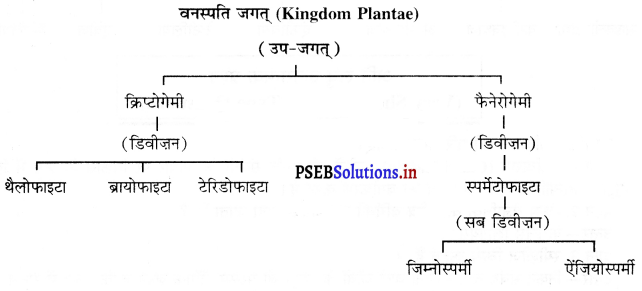
प्रश्न 25.
जंतुओं के वर्गीकरण को दर्शाते एक चार्ट बनाएं।
उत्तर-
जंतुओं के वर्गीकरण संबंधी चार्ट
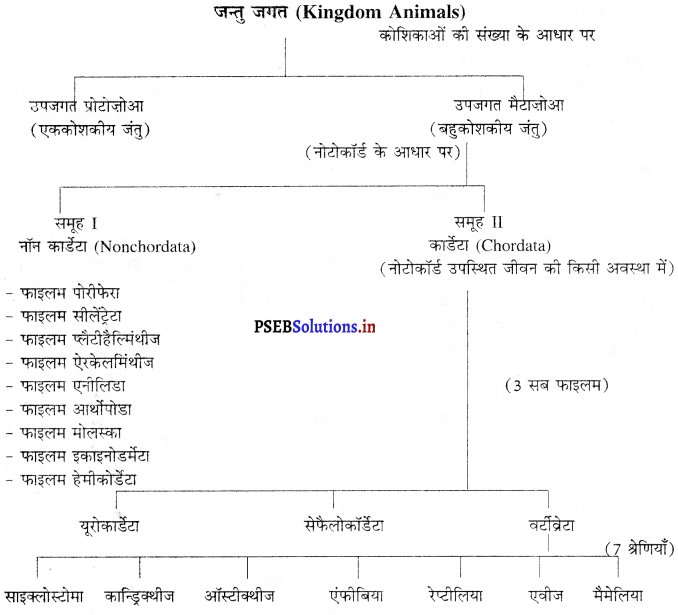
![]()
अति लघु उत्तरात्मक प्रश्न (Very Short Answer Type Questions)
प्रश्न 1.
वर्गीकरण की परिभाषा दीजिए।
उत्तर-
वर्गीकरण (Classification) – जीवों को उनके संबंधों के आधार पर विकास के क्रम में विभिन्न समूहों में विन्यासित करने की विधि को वर्गीकरण कहते हैं।
प्रश्न 2.
किस वैज्ञानिक को जीव वर्गिकी का जनक कहा जाता है ?
उत्तर-
केरोलस लिनियस।
प्रश्न 3.
स्पीशीज किसे कहते हैं ?
उत्तर-
निकट संबंध तथा संरचना वाले जीवों के समूह जो परस्पर लैंगिक जनन करके जनन में सक्षम संतानों को जन्म दें, उन्हें स्पीशीज कहते हैं।
प्रश्न 4.
पुराने तंत्र के अनुसार विश्व को कितने जगतों में बांटा गया है ?
उत्तर-
दो जगतों में-
- जगत् पादप तथा
- जगत् जंतु।
प्रश्न 5.
द्विपद नाम पद्धति किसने प्रस्तावित की ?
उत्तर-
स्वीडिश वैज्ञानिक केरोलस लिनियस ने नामकरण की द्विपद नाम पद्धति प्रस्तावित की।
प्रश्न 6.
वनस्पति जगत् के दो उप-जगतों के नाम बताइए।
उत्तर-
वनस्पति जगत् के दो उप-जगत् हैं-
- उप-जगत् क्रिप्टोगैमी (Cryptogamae) तथा
- उप-जगत् फैनेरोगैमी (Phanerogamae)।
![]()
प्रश्न 7.
शैवाल (Algae) का हरा रंग किस कारण होता है ?
उत्तर-
पर्ण हरित की उपस्थिति के कारण।
प्रश्न 8.
कवक (fungi) अपना भोगन क्यों नहीं बना सकते ?
उत्तर-
क्योंकि इनमें पर्णहरित नहीं होता।
प्रश्न 9.
आवृतबीजी पौधे कितने प्रकार के होते हैं ? उनके नाम लिखो।
उत्तर-
दो प्रकार के-दविबीजपत्री तथा एक बीजपत्री।
प्रश्न 10.
मछलियां किस अंग के द्वारा श्वसन करती हैं ?
उत्तर-
गिल्ज (गलफड़ों द्वारा )।
प्रश्न 11.
मछलियों के हृदय में कितने कोश पाए जाते हैं ?
उत्तर-
दो-
- एक आलिंद तथा
- एक निलय।
प्रश्न 12.
ओस्टीकथीज वर्ग के दो जंतुओं के नाम बताओ।
उत्तर-
- रोहू
- उड़ने वाली मछलियां (Exocopetus)
- लंग फिश।
![]()
प्रश्न 13.
फाइलम एकाइनोडर्मेटा के दो अन्य जीवों के नाम बताओ।
उत्तर-
- समुद्री आर्चिन (Sea urchin)
- कुकुमेरिया (Holothuria)
- एंटीडॉन (Feather Star) ।
प्रश्न 14.
यूरोकोर्डेटा के दो जंतुओं के नाम बताओ।
उत्तर-
- हर्डमानिया (Herdmania)
- ओइकोप्ल्यू रा।
प्रश्न 15.
एक कारटिलेजिनस मछली का नाम बताओ।
उत्तर-
भारतीय शार्क (Scolidlon) ।
प्रश्न 16.
एक बोनी मछली का नाम बताओ।
उत्तर-
लोबियो (रोहू मछली), एक्सोसीटस (Exocoectus)।
प्रश्न 17.
दो सरीसृप जंतुओं के नाम बताओ।
उत्तर-
- छिपकली
- साँप ।
प्रश्न 18.
पक्षियों के हृदय में कितने कोश होते हैं ?
उत्तर-
चार। दो आलिंद तथा दो निलय
![]()
प्रश्न 19.
किन्हीं दो स्तनधारी जीवों के नाम बताओ।
उत्तर-
- बंदर
- हाथी।
प्रश्न 20.
जैव विविधता का अध्ययन के अंतर्गत समह बनाने के क्रम में क्या सुनिश्चित किया जाता है ?
उत्तर-
वे विशिष्ट लक्षण जो जीवधारियों में मौलिक अंतर उत्पन्न करते हैं।
प्रश्न 21.
यूनानी विचारक एरिस्टोटल ने जीवों का वर्गीकरण किस आधार पर किया था ?
उत्तर-
उनके स्थल, जल और वायु में रहने के आधार पर।
प्रश्न 22.
समुद्र में रहने वाले पाँच जीवों के नाम लिखिए।
उत्तर-
रवाल, व्हेल, ऑक्टोपस, स्टारफिश, शार्क।
प्रश्न 23.
जो जीव प्रकाश संश्लेषण करते हैं उन्हें क्या कहते हैं ?
उत्तर-
हरे पौधे।
प्रश्न 24.
पौधों का शरीर किस आधार पर विकसित होता है ?
उत्तर-
भोजन बनाने की क्षमता के आधार पर।
![]()
प्रश्न 25.
जंतुओं का शरीर किस आधार पर विकसित होता है ?
उत्तर-
भोजन ग्रहण करने के आधार पर।
प्रश्न 26.
जीवों का वर्गीकरण किस वाद से संबंधित है ?
उत्तर-
जैव विकासवाद से।
प्रश्न 27.
जैव विकासवाद की अवधारणा किस ने दी थी ?
उत्तर-
चार्ल्स डार्विन ने।
प्रश्न 28.
डार्विन की जैव विकास की अवधारणा कब प्रकाश में आई थी ?
उत्तर-
सन् 1859 में डार्विन की पुस्तक ‘द ओरिजिन ऑफ स्पीशिज’ नामक पुस्तक से।
प्रश्न 29.
पहले प्रकार के जीवों को क्या कहते हैं ?
उत्तर-आदिम अथवा निम्न जीव।
प्रश्न 30.
दूसरे प्रकार के जीवों को क्या कहते हैं ?
उत्तर-
उन्नत अथवा उच्च जीव।
![]()
प्रश्न 31.
किन और कब तीन वैज्ञानिकों ने सारे सजीवों को किंगडम नामक वर्गों में विभाजित किया था ?
उत्तर-
अन्सर्ट हेकेल (1894), राबर्ट व्हिटेकर (1959) तथा कार्ल बोस (1977) ने।
प्रश्न 32.
व्हिटेकर के वर्गीकरण के पांच किंगडम कौन-से हैं ?
उत्तर-
मोनेरा, प्रोटिस्टा, फंजाई, प्लांटी और एनीमेलिया।
प्रश्न 33.
व्हिटेकर ने वर्गीकरण का आधार किसे बनाया था ?
उत्तर-
कोशिकीय संरचना, पोषण के स्रोत और तरीके तथा शारीरिक संगठन।
प्रश्न 34.
बोस ने मोनेरा किंगडम को किन दो भागों में बाँटा था ?
उत्तर-
आर्की बैक्टेरिया, यूबैक्टेरिया।
प्रश्न 35.
जीवों को किन उपसमूहों में बांटा गया है ?
उत्तर-
जगत् (किंगडम), जंतु संघ, वर्ग (क्लास), गण (ऑर्डर), कुल (फैमिली), वंश (जीनस), जाति (स्पीशीज)।
प्रश्न 36.
पादप जगत् की जगह किस शब्द का प्रयोग किया जाता है ?
उत्तर-
डिवीज़न।
![]()
प्रश्न 37.
वर्गीकरण की आधारभूत इकाई तक किस प्रकार पहुँचते हैं ?
उत्तर-
वर्गीकरण के पदानुक्रम क्रम में जीवों को विभिन्न लक्षणों के आधार पर छोटे-से-छोटे समूहों में बांटते हुए आधारभूत इकाई तक पहुंचते हैं।
प्रश्न 38.
मोनेरा वर्ग में कौन-से जीव आते हैं ?
उत्तर-
एक कोशिकीय जीव, जिन में कोशिका भित्ति पाई जाती है।
प्रश्न 39.
मोनेरा वर्ग के जीव पोषण के आधार पर कैसे हो सकते हैं ?
उत्तर-
स्वपोषी और विषमपोषी।
प्रश्न 40.
मोनेरा वर्ग के तीन उदाहरण दीजिए।
उत्तर-
जीवाणु, नीली-हरी शैवाल, माइकोप्लाज्मा।
प्रश्न 41.
प्रोटिस्टा वर्ग में गमन के लिए कौन-सी संरचनाएं पाई जाती हैं ?
उत्तर-
सीलिया, फ्लैजेला।
प्रश्न 42.
प्रोटिस्टा वर्ग के तीन उदाहरण दीजिए।
उत्तर-
एक कोशिकीय शैवाल, प्रोटोजोआ, डाइएटमस।
![]()
प्रश्न 43.
फंजाई पोषण के लिए किस पर निर्भर करती है ?
उत्तर-
सड़े-गले कार्बनिक पदार्थों पर।
प्रश्न 44.
फंजाई को मृत जीवी क्यों कहते हैं ?
उत्तर-
फंजाई गले-सड़े कार्बनिक पदार्थों पर निर्भर करती है इसलिए इसे मृत जीवी कहते हैं।
प्रश्न 45.
फंजाई के दो उदाहरण दीजिए।
उत्तर-
यीस्ट, मशरूम।
प्रश्न 46.
सहजीविता किसे कहते हैं ?
उत्तर-
कवकों की कुछ जातियां नीले हरे शैवाल के साथ स्थार्य अंतर्संबंध बनाती है जिसे सहजीविता कहते हैं।
प्रश्न 47.
ऐनिमेलिया वर्ग में कौन-से जीव आते हैं ?
उत्तर-
इस वर्ग में सभी बहुकोशिकीय यूकेरियोटिक जीव आते हैं जिनमें कोशिका भित्ति नहीं पाई जाती है।
प्रश्न 48.
थैलोफाइटा वर्ग में प्रमुख रूप से कैसे पौधे पाए जाते हैं ?
उत्तर-
जल में पाए जाने वाले शैवाल।
![]()
प्रश्न 49.
थैलोफाइटा वर्ग के तीन उदाहरण दीजिए।
उत्तर-
यूलोथ्रिक्स, स्पाइरोगाइरा, कारा।
प्रश्न 50.
ब्रायोफाइटा के दो उदाहरण दीजिए।
उत्तर-
मॉस (प्यूनेरिया), मार्केशिया।
प्रश्न 51.
जिन में बीज उत्पन्न करने की क्षमता नहीं होती उन्हें क्या कहते हैं ?
उत्तर-
क्रिप्टोगैम्स।
प्रश्न 52.
फेरोगेम्स किसे कहते हैं ?
उत्तर-
वे पौधे जिनमें जनन ऊतक पूरी तरह विकसित और विभेदित होते हैं तथा जनन प्रक्रिया के बाद बीज उत्पन्न करते हैं, उन्हें फेरोगेम्स कहते हैं।
प्रश्न 53.
एंजियोस्पर्म पौधे क्या हैं ?
उत्तर-
जिन पौधों के बीज फलों के अंदर ढके होते हैं उन्हें एंजियोस्पर्म कहते हैं। इन के बीज बाद में फल बन जाते हैं।
प्रश्न 54.
एंजियोस्पर्म वर्ग को किन दो भागों में बांटा गया है ?
उत्तर-
- एक बीज पत्री,
- द्वि बीज पत्री।
![]()
प्रश्न 55.
जिम्नोस्पर्म पौधे क्या है ?
उत्तर-नग्न बीज उत्पन्न करने वाले पौधे ।
प्रश्न 56.
एक बीज पत्री के दो उदाहरण दीजिए।
उत्तर-
गेहूँ, मक्का ।
प्रश्न 57.
दवि बीज पत्री के दो उदाहरण दीजिए। उत्तर-चना, मटर।
प्रश्न 58.
पोरीफेरा शब्द किस से बना है ?
उत्तर-
पोरीफेरा लेटिन शब्द ‘पोरस’ तथा ‘फेरी’ से बना है। ‘पोरस’ का अर्थ है-छिद्र तथा ‘फेरी’ का अर्थ है ‘रखना’।
प्रश्न 59.
प्रायः पोरीफेरा को किस नाम से जाना जाता है ?
उत्तर-
स्पाँज।
प्रश्न 60.
पोरीफेरा के तीन उदाहरण दीजिए।
उत्तर-
साइकान, यूप्लेक्टोलिया, स्पांजिला।
![]()
प्रश्न 61.
सीलेंटरेटा कैसे जंतु हैं ?
उत्तर-
जलीय जंतु।
प्रश्न 62.
सीलेंटरेटा जंतुओं के समूह और एकाकी रहने वाले जीवों के उदाहरण लिखिए।
उत्तर-
समूह में रहने वाले = कोरल
एकाकी रहने वाले = हाइड्रा।
प्रश्न 63.
सीलेंटरेटा जंतुओं के तीन उदाहरण लिखिए।
उत्तर-
हाइड्रा, समुद्री एनीमोन, जेलीफिश।
प्रश्न 64.
प्लेटीहेल्मिथीज को चपटे कृमि क्यों कहते हैं ?
उत्तर-
इनका शरीर पृष्ठधारीय और चपटा होता है।
प्रश्न 65.
चपटे कृमि वर्ग के तीन उदाहरण दीजिए।
उत्तर-
लीवरफ्लूयक, प्लेनेरिया, फीताकृमि।
प्रश्न 66.
परजीवियों के तीन उदाहरण दीजिए।
उत्तर-
गोल कृमि, फाइलेरिया कृमि, पिन कृमि।
![]()
प्रश्न 67.
एनीलिडा वर्ग के तीन उदाहरण लिखिए।
उत्तर-
केंचुआ, नीरीस, जोंक।
प्रश्न 68.
जंतु जगत् का सबसे बड़ा भाग कौन-सा है ?
उत्तर-
आर्थोपोडा।
प्रश्न 69.
आर्थोपोडा के पांच उदाहरण दीजिए।
उत्तर-
प्रॉन, तितली, मक्खी, मकड़ी, बिच्छू, केकड़ा।
प्रश्न 70.
मोलस्का वर्ग के तीन उदाहरण दीजिए।
उत्तर-
यूनियो, घंघा, ऑक्टोपस।
प्रश्न 71.
इकाइनोडर्मेटा वर्ग के दो उदाहरण दीजिए।
उत्तर-
स्टारफिश, समुद्री आर्चिन।
प्रश्न 72.
प्रोटोकाटा वर्ग के तीन उदाहरण दीजिए।
उत्तर-
बैलेनोग्लासस, हार्डमेनिया, एंपीयाक्सस।
![]()
प्रश्न 73.
वर्टीब्रेटा किसे कहते हैं ?
उत्तर-
जिन जंतुओं में वास्तविक मेरुदंड और अंत: कंकाल होता है तथा पेशियां कंकाल से जुड़ी होती हैं जो इन्हें चलने में सहायता करती हैं उन्हें वर्टीब्रेटा कहते हैं।
प्रश्न 74.
सभी कशेरुकाओं के प्रमुख लक्षण लिखिए।
उत्तर-
नोटोकार्ड, कशेरुक दंड और मेरुरज्जु, त्रिकोरिक, शरीर, जोड़ीदार गलफड़, देह गुहा।
प्रश्न 75.
मत्स्य श्वसन के लिए किस अंग का प्रयोग करते हैं ?
उत्तर-
गलफड़ों का।
प्रश्न 76.
मत्स्य वर्ग के चार उदाहरण दीजिए।
उत्तर-
टूना, रोहू, स्कालियेडान, टारपीडो।
प्रश्न 77.
जल, स्थलचर साँस किस से लेते हैं ?
उत्तर-
गलफडों या फेफडों से।
प्रश्न 78.
जल, स्थलचर के वर्ग के तीन जीवों के उदाहरण लिखिए।
उत्तर-
मेंढक, सेलमेंडर, टोड।
![]()
प्रश्न 79.
उस सरीसृप वर्ग के जीव का नाम लिखिए जिस के हृदय में चार कक्ष होते हैं ?
उत्तर-
मगरमच्छ।
प्रश्न 80.
सरीसृप वर्ग के चार जंतुओं के नाम लिखिए।
उत्तर-
कछुआ, सांप, गिरगिट, मगरमच्छ।
प्रश्न 81.
पक्षी कैसे प्राणी हैं ?
उत्तर-
समतापी प्राणी।
प्रश्न 82.
पक्षियों में आगे वाले पैर किस में परिवर्तित हो चुके हैं ?
उत्तर-
पंखों में।
प्रश्न 83.
पक्षियों के हृदय में कितने कक्ष होते हैं ?
उत्तर-
चार कक्ष।
प्रश्न 84.
किस वैज्ञानिक ने नाम पद्धति का सबसे पहले प्रयोग किया था ?
उत्तर-
केरोलिस लीनियस ने अठारहवीं शताब्दी में।
![]()
प्रश्न 85.
प्रजाति का नाम किस प्रकार से शुरू किया जाता है ?
उत्तर-
अंग्रेजी छोटे अक्षर से।
प्रश्न 86.
जीनस के नाम किस अक्षर से शुरू किए जाते हैं ?
उत्तर-
अंग्रेजी के बड़े अक्षर से।
प्रश्न 87.
केरोलस लीनियस ने विभिन्न वर्गीकरण प्रणालियों के आधार रूप में किस पुस्तक की रचना की थी ?
उत्तर-
‘सिस्टेमा नेचुरी’।


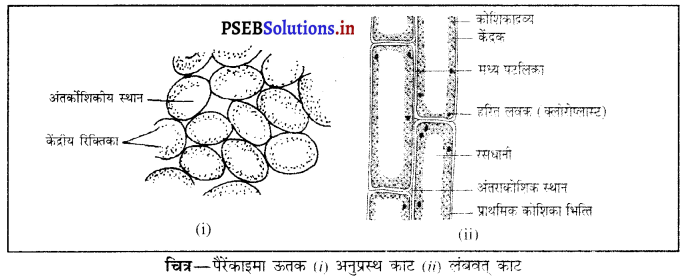
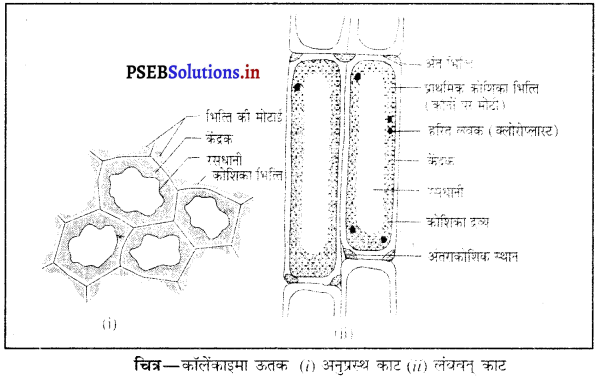
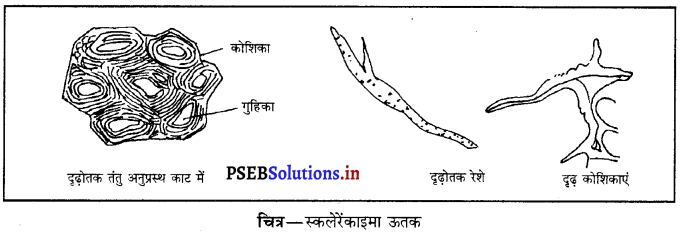
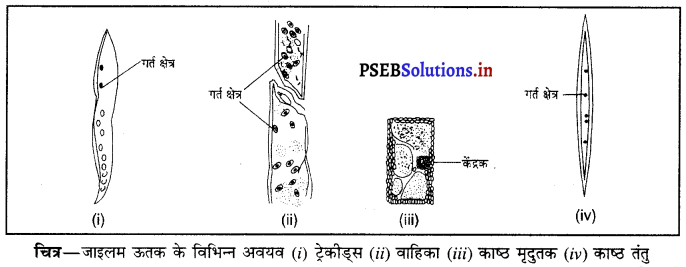
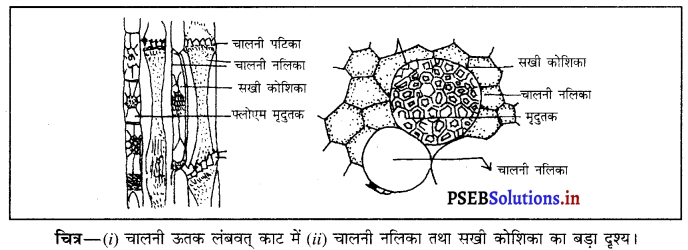

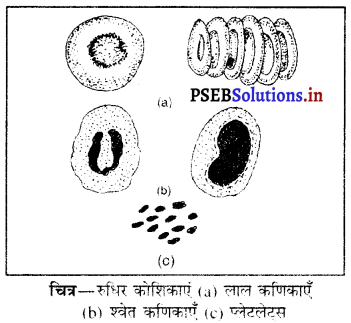
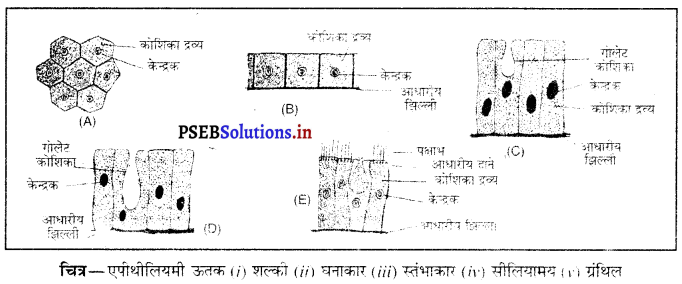

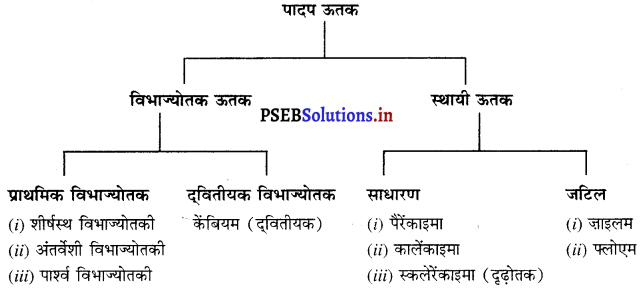


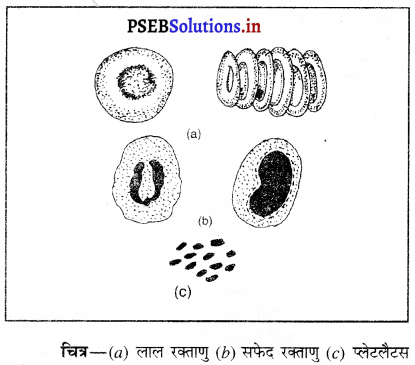
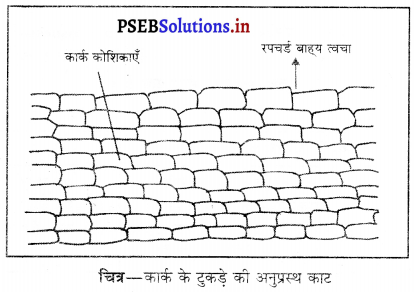

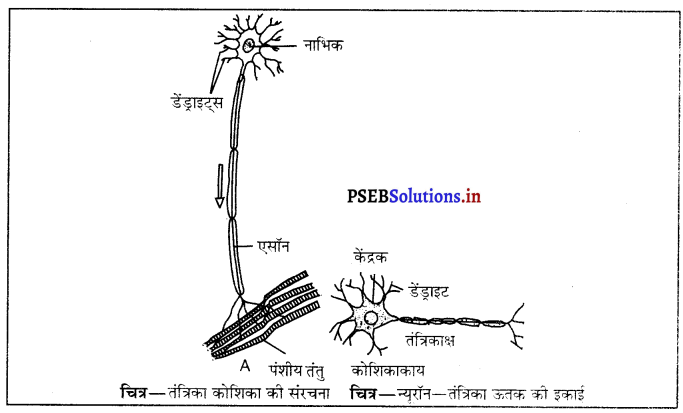
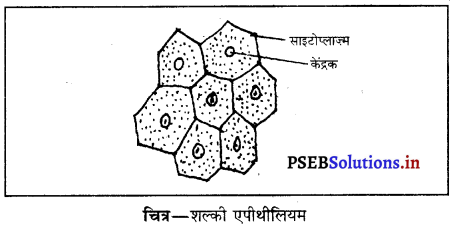


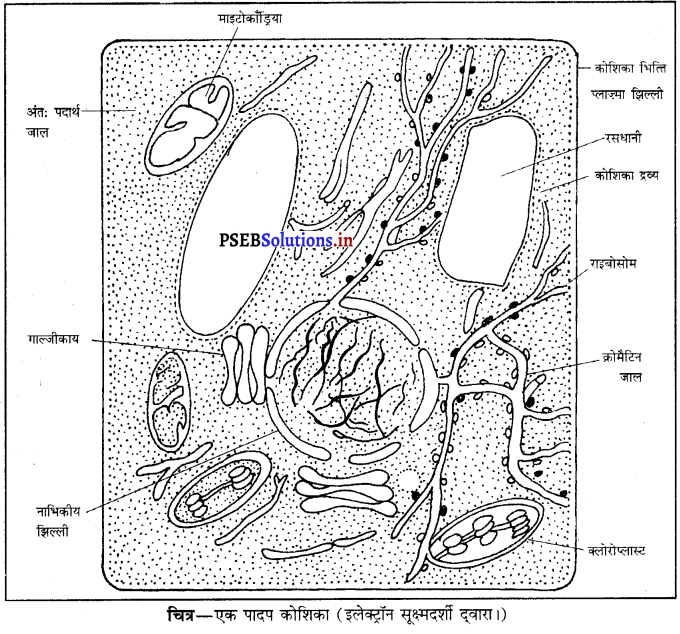
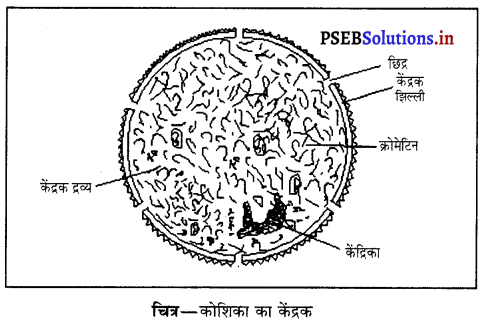
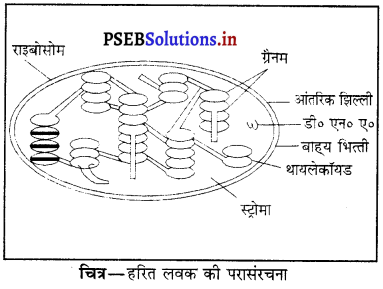


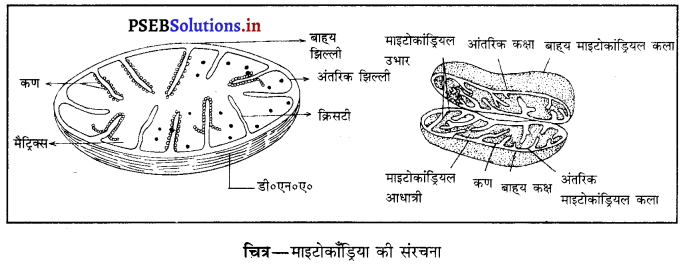

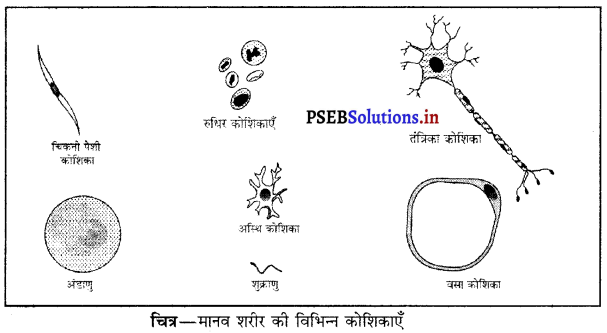
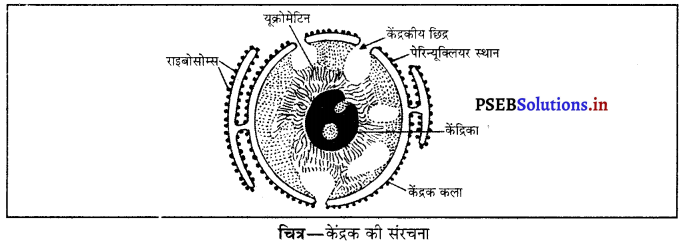
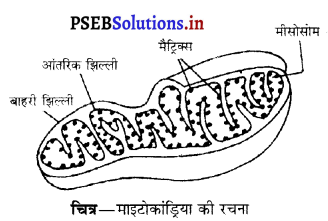

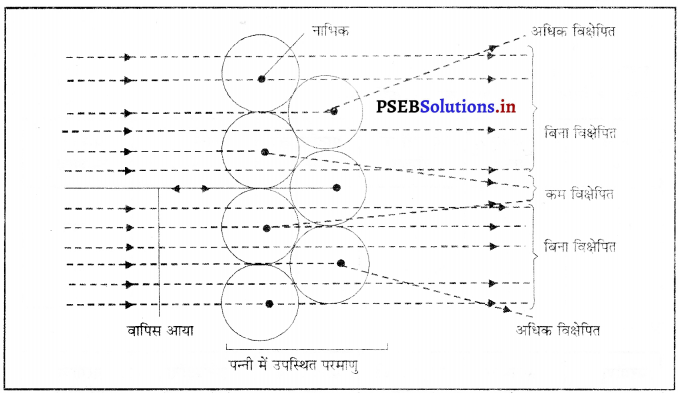
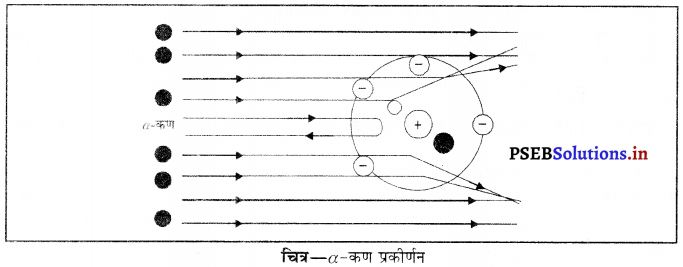


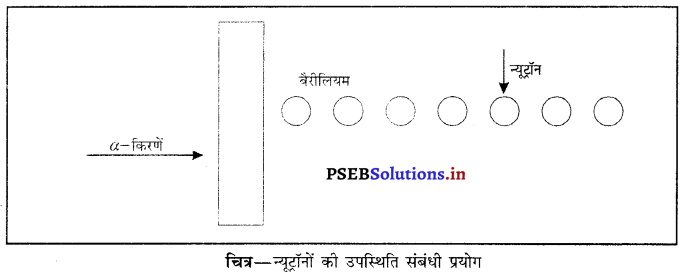
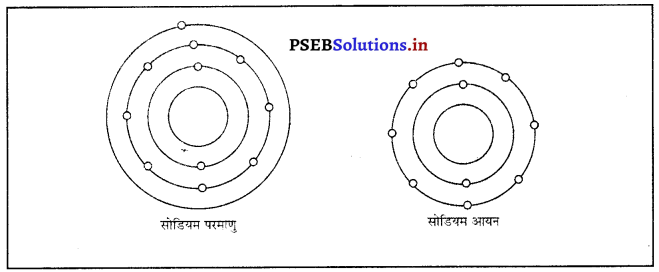
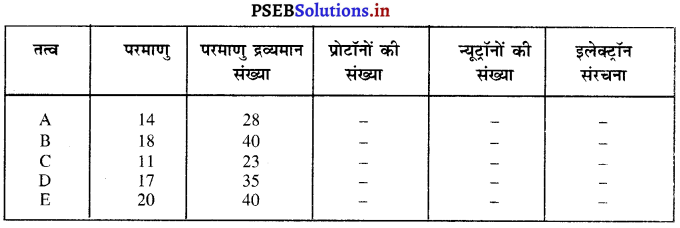
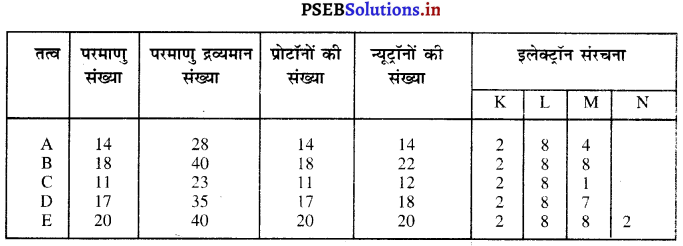





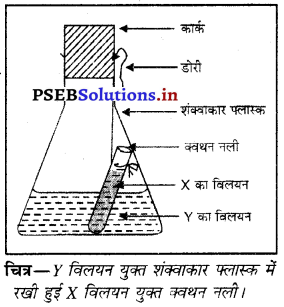
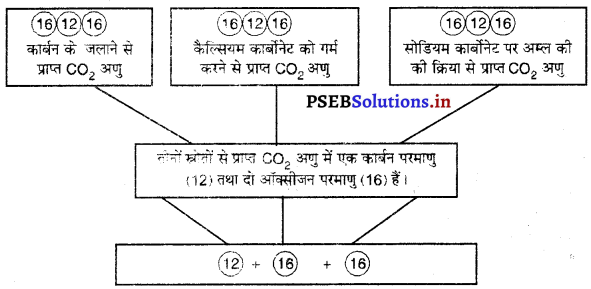
















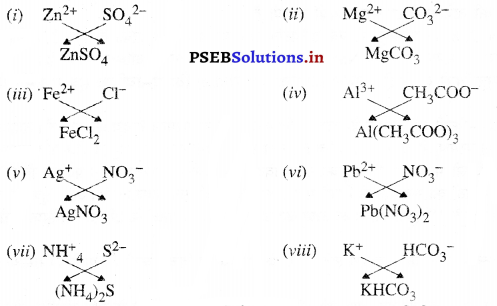
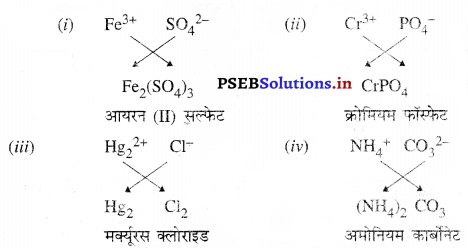
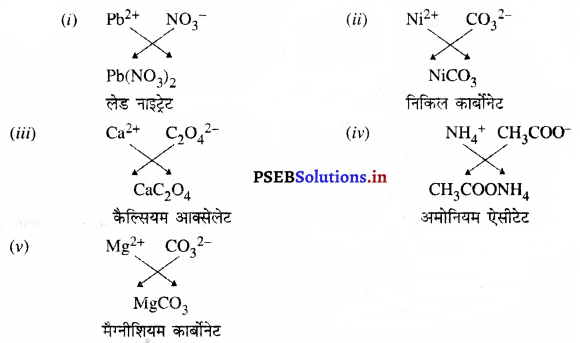





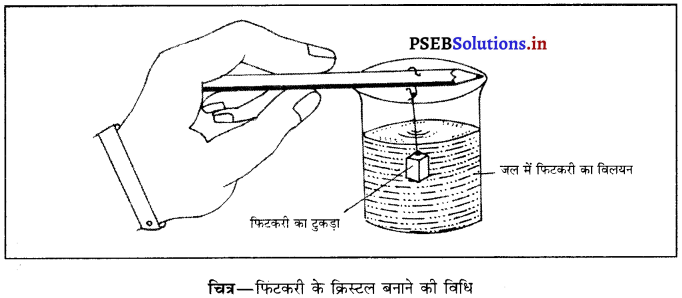
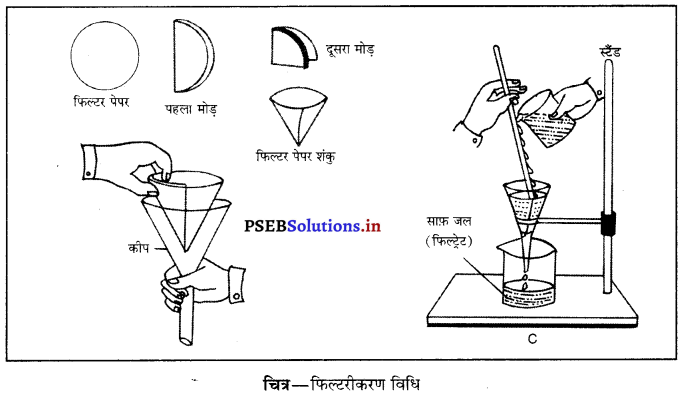
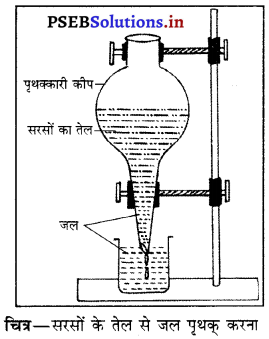
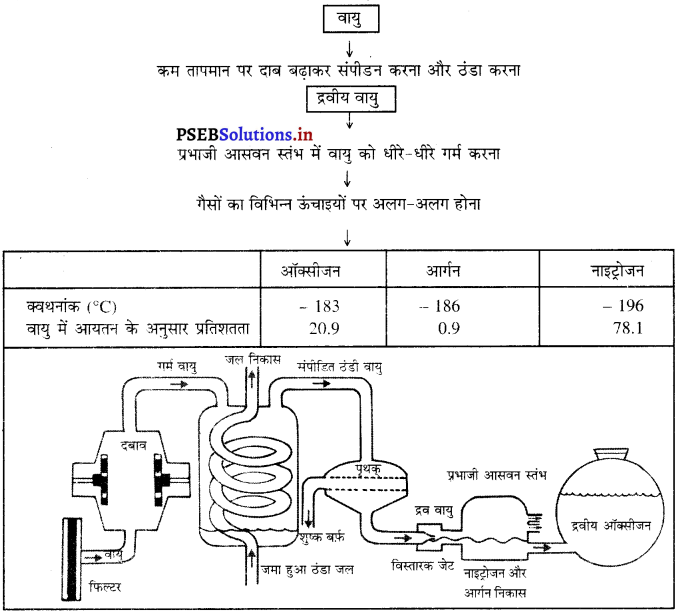
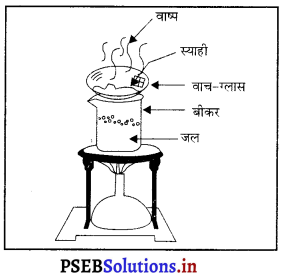
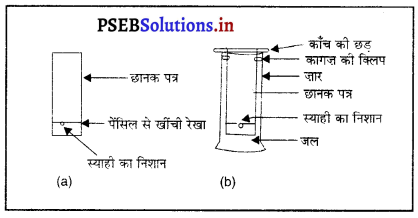
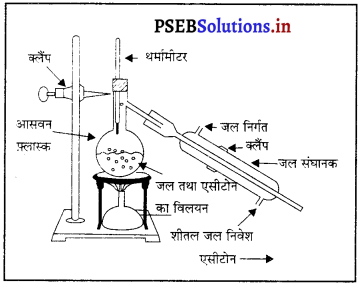
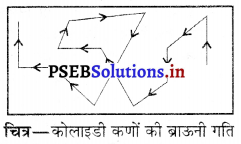
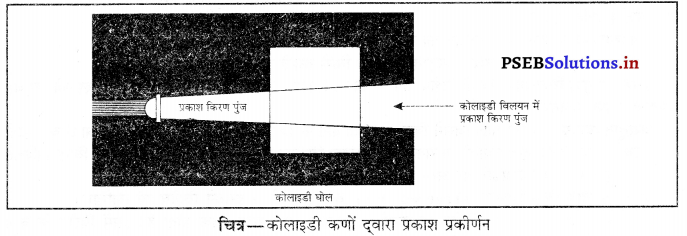
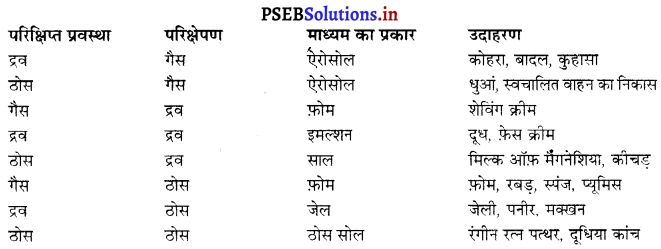
 × 100
× 100